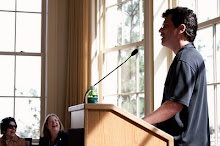In Austen L and Janeites, Anielka Briggs posted this followup question to the "quadrille" discussion she initiated yesterday:
"What is the name of the fairy who dropt a piece of paper?"
I just gave the following reply:
When I was one of the many speakers at the Chawton House Jane Austen conference last July, I disclosed my opinion, among many others I put forward, that in the shadow story (but NOT the overt story) of the novel, the AUTHOR of the "courtship" charade was FRANK CHURCHILL, who was the "friend" referred to by Mr. Elton earlier in Chapter 9:
"He called for a few moments, just to leave a piece of paper on the table containing, as he said, a charade, which A FRIEND OF HIS had addressed to a young lady, the object of his admiration, but which, from his manner, Emma was immediately convinced must be his own."
In real life, of course, the author of the "courtship" charade was Jane Austen herself, and there is a story in that regard as well. As I revealed when I spoke at Oxford in July, 2007, in 1993, Margaret Doody, an excellent literary scholar, inadvertently created confusion about the real life authorship of that charade, when, in a book discussing Jane Austen, Doody claimed that JA had not written the "courtship" charade herself, but had found it in a popular charade book from 1790, long before JA wrote Emma. I first read about Doody's attribution in early 2006, when I already knew of Colleen Sheehan's discovery of the "Prince of Whales" solution to that charade, so I thought Doody's attribution had to be a mistake, because it seemed clear to me that JA had written that charade right around the time she wrote Emma, in 1814-5, and with Emma very specifically in mind. It is in so many ways tailor-made to (or to use a mathematical term as befits this recent discussion, congruent with) the novel itself.
I was therefore very happy when I obtained a copy of, and thumbed through, the actual charade book, and saw that there was ANOTHER charade with the solution "courtship", which was completely different from the one we all know from Chapter 9 of Emma! Perhaps that earlier one gave JA the original idea to write hers, but she herself undoubtedly crafted her own "courtship" charade herself to meet her own very special purposes for the interpretation of Emma.
Anyway, back to Emma's reference to a "fairy" for one additional wrinkle----I also disclosed at Chawton House that while Emma may have intended a clever allusion to A Midsummer Night's Dream, her unintended meanings throughout the novel are almost always quite significant and quite funny, in a way Emma would, however, definitely NOT enjoy. As we were told earlier in that same Chapter 9 that Mr. Elton was the person who physically handed the "courtship" charade to Emma and Harriet, he is, in that sense, the "fairy" whom Emma refers to. But as always with JA, there are other clues elsewhere in the novel which connect to each other across chapters and volumes. And in this instance, JA gives us a further clue in that regard via the "foolish" comments of Miss Bates in Chapter 38 when Miss Bates says:
"This is meeting quite in fairy-land! Such a transformation! Must not compliment, I know -- (eyeing Emma most complacently) -- that would be rude -"
I also disclosed at Chawton House last July that my "shadow" interpretation of Miss Bates's reference to "fairy land" was that, among the multiple plausible interpretations of the innuendoes being raised by Miss Bates at that moment, one of them is the doubt Miss Bates raises as to the firmness of Mr. Elton's commitment to heterosexuality, in marrying his new bride--hence "SUCH a transformation!" Miss Bates perhaps is also aware of the lack of fruition of Mr. Elton's "shadow" liaisons with Harriet, which are emblematized in Harriet's initially treasuring, but eventual jettisoning, poor Mr. Elton's leadless "pencil"!
Cheers,
ARNIE
Popular Posts
- Deirdre Le Faye & Me: "I am a scholar, she is a scholar: so far we are equal"
- Darcy's "We neither of us perform to strangers": a Radical New Interpretation
- The Hunger Games’s Veiled Allusion to Shakespeare’s Titus Andronicus
- Rick Santorum would have been the worst person in the world to Jane Austen too!
- August Wayne Booth in Once Upon A Time: Jane Austen Really IS Everywhere in 2012!
- 20 shades of hero/villain Mr. Darcy
- Can Jane Austen forgive Marianne?
- Miss Bennet, Elizabeth, Lizzy, Eliza: who calls her what....and why
- The Great Gadsby: an overnight lesbian feminist ‘comedy’ sensation 10+ years in the making (& 3 millenia overdue)
- Austenland: The Movie was Fun, but the Novel was Better [SPOILER ALERT as to both]
Saturday, February 13, 2010
Subscribe to:
Post Comments (Atom)

No comments:
Post a Comment